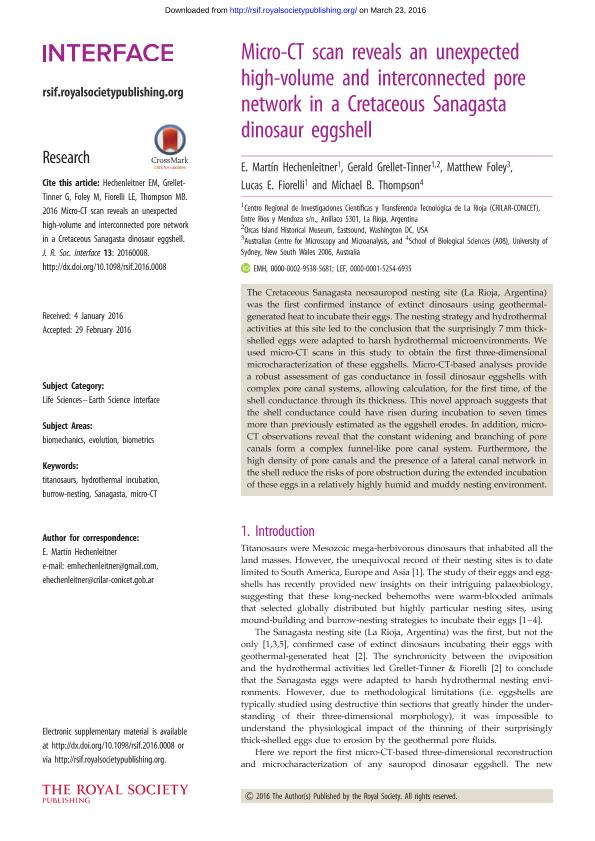Artículo
Micro-CT scan reveals an unexpected high-volume and interconnected pore network in a Cretaceous Sanagasta dinosaur eggshell
Hechenleitner, Esteban Martín ; Grellet-tinner, Gerald; Foley, Matthew; Fiorelli, Lucas Ernesto
; Grellet-tinner, Gerald; Foley, Matthew; Fiorelli, Lucas Ernesto ; Thompson, Michael
; Thompson, Michael
 ; Grellet-tinner, Gerald; Foley, Matthew; Fiorelli, Lucas Ernesto
; Grellet-tinner, Gerald; Foley, Matthew; Fiorelli, Lucas Ernesto ; Thompson, Michael
; Thompson, Michael
Fecha de publicación:
03/2016
Editorial:
The Royal Society
Revista:
Journal of the Royal Society Interface
ISSN:
1742-5689
Idioma:
Inglés
Tipo de recurso:
Artículo publicado
Clasificación temática:
Resumen
The Cretaceous Sanagasta neosauropod nesting site (La Rioja, Argentina) was the first confirmed instance of extinct dinosaurs utilizing geothermal-generated heat to incubate their eggs. The nesting strategy and hydrothermal activities at this site led to the conclusion that the surprisingly 7 mm thick shelled eggs were adapted to harsh hydrothermal microenvironments. We used micro-CT scans in this study to obtain the first three-dimensional microcharacterization of these eggshells. Micro-CT based analyses provide a robust assessment of gas conductance in fossil dinosaur eggshells with complex pore canal systems, allowing calculation, for the first time, of the shell conductance through its thickness. This novel approach suggests that the shell conductance could have risen during incubation to 7 times more than previously estimated as the eggshell erodes. In addition, micro-CT observations reveal that the constant widening and branching of pore canals form a complex funnel-like pore canals system. Furthermore, the high density of pore canals and the presence of a lateral canal network in the shell reduce the risks of pore obstruction during the extended incubation of these eggs in a relatively highly humid and muddy nesting environment.
Palabras clave:
Titanosaurs
,
Hydrothermal Incubation
,
Burrow-Nesting
,
Sanagasta
,
Micro-Ct
Archivos asociados
Licencia
Identificadores
Colecciones
Articulos(CRILAR)
Articulos de CENTRO REGIONAL DE INV. CIENTIFICAS Y TRANSFERENCIA TECNOLOGICA DE ANILLACO
Articulos de CENTRO REGIONAL DE INV. CIENTIFICAS Y TRANSFERENCIA TECNOLOGICA DE ANILLACO
Citación
Hechenleitner, Esteban Martín; Grellet-tinner, Gerald; Foley, Matthew; Fiorelli, Lucas Ernesto; Thompson, Michael; Micro-CT scan reveals an unexpected high-volume and interconnected pore network in a Cretaceous Sanagasta dinosaur eggshell; The Royal Society; Journal of the Royal Society Interface; 13; 116; 3-2016; 1-6
Compartir
Altmétricas



